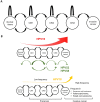Carcinogenesis and management of human papillomavirus-associated cervical cancer
- PMID: 37294390
- PMCID: PMC10390372
- DOI: 10.1007/s10147-023-02337-7
Carcinogenesis and management of human papillomavirus-associated cervical cancer
Abstract
Approximately 95% of cervical cancer are caused by human papillomavirus (HPV) infection. Although it is estimated that HPV-associated cervical cancer will decrease with the widespread use of HPV vaccine, it may take time for HPV-associated cervical cancer to be eliminated. For the appropriate management of HPV-associated cervical cancer, it is important to understand the detailed mechanisms of cervical cancer development. First, the cellular origin of most cervical cancers is thought to be cells in the squamocolumnar junction (SCJ) of the uterine cervix. Therefore, it is important to understand the characteristics of SCJ for cervical cancer screening and treatment. Second, cervical cancer is caused by high risk HPV (HR-HPV) infection, however, the manner of progression to cervical cancer differs depending on the type of HR-HPV: HPV16 is characterized by a stepwise carcinogenesis, HPV18 is difficult to detect in precancerous lesions, and HPV52, 58 tends to remain in the state of cervical intraepithelial neoplasia (CIN). Third, in addition to the type of HPV, the involvement of the human immune response is also important in the progression and regression of cervical cancer. In this review, we demonstrate the carcinogenesis mechanism of HPV-associated cervical cancer, management of CIN, and the current treatment of CIN and cervical cancer.
Keywords: Cervical cancer; Human papillomavirus; Squamocolumnar junction.
© 2023. The Author(s).
Conflict of interest statement
No author has any conflict of interest.
Figures




References
-
- National Cancer Center Japan Cancer registry and statistics (JP). Cancer Information Service. Available from https://ganjoho.jp/reg_stat/statistics/dl/index.html. Accessed Feb 2023.
-
- Nagase S, Ohta T, Takahashi F, et al. Annual report of the committee on gynecologic oncology, the Japan society of obstetrics and gynecology: annual patient report for 2018 and annual treatment report for 2013. J Obstet Gynaecol Res. 2022;48:541–552. - PubMed

